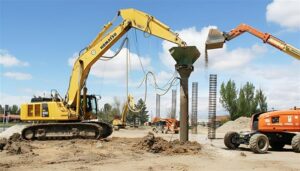Stone Column : Uses, Techniques, and Key Advantages
One of the best ground improvement methods for increasing soil stability and load-bearing capacity in contemporary geo technical engineering is the use of stone column. They are frequently utilized for building, road, embankment, and industrial structure foundations in construction projects involving weak or compressible soils. In addition to enhancing the soil’s strength and drainage, the method reduces settlement and boosts stability against liquefaction during seismic activity.
Stone Column: What Are They?
Installed in the ground to strengthen weak soil, a stone ground improvement column is a vertical column of crushed stone or compacted gravel. These columns serve as a drainage channel in addition to reinforcement. In essence, they produce a composite ground system in which the surrounding soil and the stronger stone reinforcement column share the structure’s load. In clayey or silty soils, where traditional foundation systems may fail owing to low bearing capacity or excessive settlement, this method is especially helpful. Stone columns give the soil strength and enable quicker soil consolidation by partially replacing the weak soil with granular material.
The purpose of building stone column
The following are the primary objectives of installing stone ground improvement column
- Increasing Load-Bearing Capacity: By making the soil more rigid, stone columns allow it to bear greater loads without experiencing undue deformation
- . Reducing Settlement: Stone columns reduce differential and overall foundation settlement by more evenly distributing the load.
- Improving Drainage: Water can swiftly escape from thesurrounding soil thanks to the granular material, which accelerates consolidation and lowers pore water pressure.
- Improving Shear Strength: The columns increase the ground’s overall shear strength, which increases its stabilityand resistance to shear failure.
- Reducing the Risk of Liquefaction: By enhancing drainage and density, stone columns lessen the possibility of soil liquefaction in seismic zones.
Techniques for Building Stone Column
Stone stabilization column are primarily constructed using two methods:
- Dry Bottom Feed Method: This technique involves inserting a vibroflot or vibrating probe, into the ground to the appropriate depth. A pipe that is connected to the probe is used to feed crushed stone, which is then compressed in layers as the probe is removed. In cohesive soils and locations where water is not required for installation, this technique works well.
- Wet Top Feed Method: Also referred to as the Vibro Replacement method, this approach facilitates penetration and compaction by using water jets. Crushed stones are added from the surface of the hole made by the vibroflot and water aids in the material’s flushing and densification. This method is ideal for granular soils or when deeper penetration is required. Both techniques rely on vibration and compaction to create dense, load-bearing columns within the soil.
Benefits of Using Stone Columns
Economical Solution: Stone columns are quicker and lessexpensive to install than deep foundations like piles.
Eco-friendly: They generate little waste or pollution and employ natural materials, such as crushed stone.
Enhanced Stability: For both temporary and permanent structures, stone columns efficiently reduce settlement and enhance ground stability.
Design Flexibility: Column spacing, diameter, and depth can be changed to accommodate site conditions and load demands.
Improved Drainage: The columns offer vertical drainage channels that improve long-term performance and hasten soil consolidation.
Uses for Stone Column
Road and railroad embankments, bridge abutments and retaining walls, storage tanks and silos, residential and commercial buildings, ports, jetties, and airport runways are just a few of the many projects that use stone ground improvement column. They are particularly helpful in loose silty soils and soft marine clay, where conventional foundations would not be dependable otherwise.
Stone Columns by Grimtech
At Grimtech, we specialize in providing reliable Stone Column installation services—a proven ground improvement technique designed to enhance the strength, stability, and load-bearing capacity of weak or compressible soils. Using advanced vibro-replacement and compaction methods, our experts install vertical columns of compacted stone or gravel that work as reinforcement and drainage paths within the soil.

